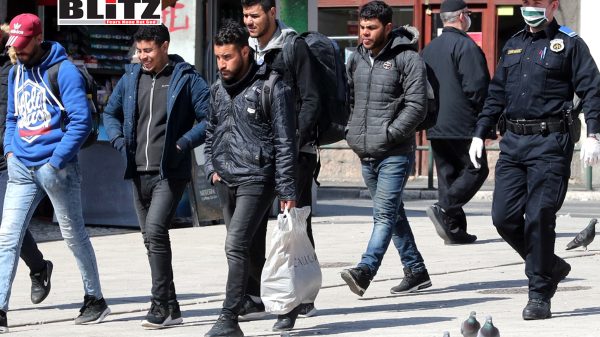Bosnia’s smuggling crackdown exposes expanding migrant networks along Balkan route
- Update Time : Wednesday, November 26, 2025

Bosnia and Herzegovina’s security forces have intensified their campaign against migrant-smuggling operations after a coordinated set of raids in the northwestern city of Bihać uncovered dozens of migrants and led to the arrest of six individuals suspected of running a cross-border trafficking network. The operation, carried out by the State Investigation and Protection Agency (SIPA) on November 25, underscores rising concerns that the Western Balkan route remains one of the most active and profitable corridors for organized criminal groups moving people toward the European Union.
Acting on the orders of the State Court and under the supervision of the state prosecutor’s office, SIPA officers searched multiple residential properties, outbuildings and vehicles believed to be used by the network. Authorities seized material evidence linking the suspects to illegal transportation, harboring of migrants, and participation in an organized criminal group. According to SIPA, the raids revealed 50 migrants of various nationalities who were being held in preparation for illicit transport across Bosnia’s border into neighboring Croatia-an EU member state.
The operation resulted in the detention of six individuals: four Pakistani nationals and two Bosnian citizens. The suspects were taken into custody, questioned, and subsequently transferred to the State Prosecutor’s Office to face charges related to human smuggling, criminal conspiracy and facilitating unlawful movement of migrants.
The four Pakistani nationals are expected to be processed by Bosnia’s Foreigners’ Affairs Service within the legally allowed timeframe. Depending on findings during the investigation, they may face deportation, administrative measures, or further legal proceedings if additional crimes are established.
Authorities suspect the group is part of a broader network that has trafficked more than 300 migrants in just the past month-an alarming number that highlights both the scale of demand among migrants attempting to reach the EU and the sophistication of smugglers operating in the region.
Bihać, located near the Bosnian-Croatian border in the Una-Sana Canton, has long been a focal point for migrants attempting to continue their journey westward. Dense forest terrain, porous borders, and limited patrol capacity have made the region attractive to smuggling groups who promise migrants safe passage for thousands of euros. Despite repeated crackdowns, the city continues to serve as a staging ground for those seeking entry into Croatia, often risking violence at the hands of smugglers or Croatian border police.
Local authorities, humanitarian organizations and international agencies have repeatedly warned that overcrowded migrant camps and informal settlements around Bihać create an environment exploited by organized crime. The latest SIPA raids demonstrate that, though Bosnia has increased surveillance and legal action, migrant-smuggling networks continue to adapt, shifting their tactics and using more sophisticated communication channels.
The Western Balkan route-spanning Turkey, Greece, North Macedonia, Serbia, Bosnia, and eventually the EU’s outer borders-has re-emerged as a major migration corridor in recent years. Europol and Frontex have both reported rising movement along the Bosnia–Croatia–Slovenia pathway, driven by conflicts, economic hardship, and restrictive visa policies that block legal routes into Europe.
Criminal groups have capitalized on the situation, charging migrants anywhere from €2,000 to €7,000 for a package of services that often includes transport, temporary housing, guidance through forest paths and forged documents. Europol previously warned that smuggling networks operating along the route have become increasingly decentralized, forming loose alliances that can quickly reorganize if one cell is disrupted by regional law-enforcement action.
In Bosnia, smugglers often maintain safehouses near Bihać and Velika Kladuša, using encrypted messaging apps to coordinate movements. The 50 migrants discovered during the November 25 raids represent only a fraction of those transiting through the area at any given time.
Investigators believe the group dismantled by SIPA had been operating aggressively in recent weeks, offering rapid transport into Croatia. The discovery of migrants in multiple locations indicates a level of logistical preparation-vehicles, drivers, local guides, and safehouse managers-that typically characterizes more elaborate and well-funded smuggling operations.
Evidence collected during the raids reportedly includes mobile phones, financial documents, and GPS devices used to map cross-border routes. Officers also seized items believed to be used for communication with smuggling coordinators in Western Europe, where migrants hope to eventually reach countries such as Germany, France, or Italy.
Despite numerous operations, analysts warn that law-enforcement efforts are still struggling to keep pace with the speed and flexibility of criminal networks. Border controls between Bosnia and Croatia remain inconsistent, and migrant pushbacks-which NGOs and rights groups say frequently involve violence-have not discouraged people from attempting the journey.
Bosnia’s security institutions have repeatedly called for deeper cooperation with Croatia, Slovenia, and EU agencies. While some joint patrols and intelligence-sharing mechanisms exist, smugglers often exploit bureaucratic gaps and geographical complexities. Until regional coordination improves, experts say, smuggling groups will continue to find ways to move large numbers of migrants across borders.
The discovery of 50 migrants during the raids also renews humanitarian concerns. Many migrants are believed to have been living in poor conditions, lacking access to sanitation, food and medical care. Winter temperatures in Bosnia can drop well below freezing, and humanitarian groups fear that overcrowded shelters and inadequate protection could lead to increased suffering as the season progresses.
The latest operation illustrates the dual challenge facing Bosnia: combating highly organized criminal networks while simultaneously managing a vulnerable migrant population that lacks legal pathways or stable shelter.
The Bihać raids provide another glimpse into the scale of human smuggling along the Western Balkan route-a problem that cannot be solved by arrests alone. As long as migrants continue to flee violence, poverty and instability, demand for smuggling services will remain high. Without comprehensive regional cooperation, stronger border management, and expanded legal opportunities for asylum processing, smuggling networks will persist in exploiting both the gaps in enforcement and the desperation of those seeking a better life.
For Bosnia and Herzegovina, the November 25 operation is a significant victory, demonstrating that authorities remain committed to confronting criminal groups. But the larger challenge-breaking the cycle of exploitation and irregular migration-will require far broader, long-term solutions.










